H BR
Page 34
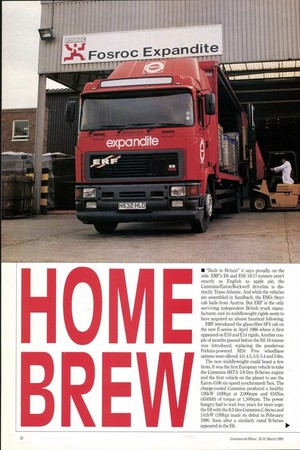
Page 35
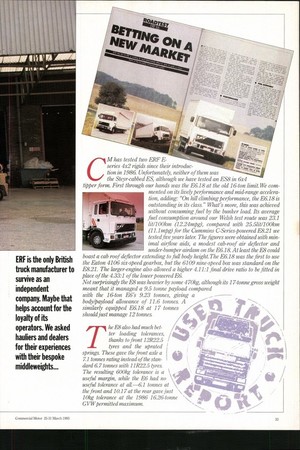
Page 36
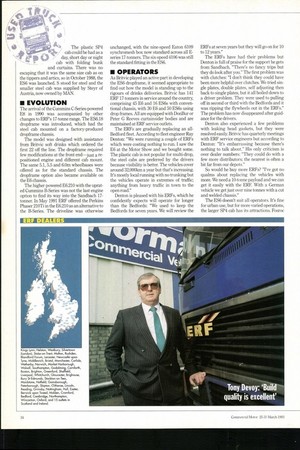
Page 37

Page 38
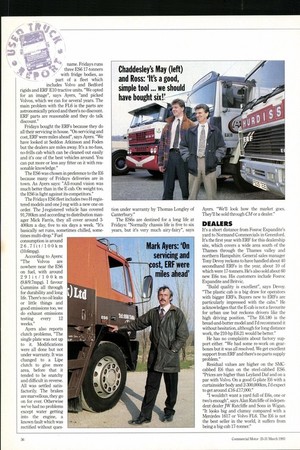
Page 39
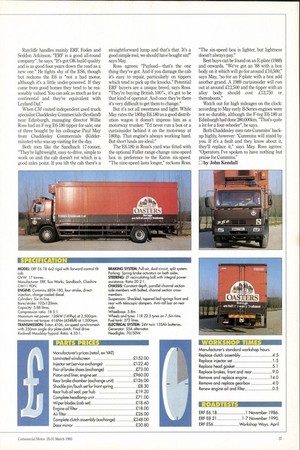
If you've noticed an error in this article please click here to report it so we can fix it.
ERF is the only British truck manufacturer to survive as an independent company. Maybe that helps account for the loyalty of its operators. We asked hauliers and dealers for their experiences with their bespoke middleweights...
CM has tested two ERF Eseries 4x2 rig ids since their introduction in 1986. Unfortunately, neither of them was the Steyr-cabbed ES, although we have tested an ES8 in 6x4 tipper form. First through our hands was the E6.18 at the old 16-ton limit. We commented on its lively performance and mid-range acceleration, adding: "On hill climbing performance, the E6.18 is outstanding in its class." What's more, this was achieved without consuming fuel by the bunker load. Its average fuel consumption around our Welsh test route was 23.1 lit/100km (12.24mpg), compared with 25.5lit/100km (11.1mpg) for the Cummins C-Series-powered E8.21 we tested five years later The figures were obtained with minimal airflow aids, a modest cab-roof air deflector and under-bumper airdam on the E6.18. At least the E8 could boast a cab roof deflector extending to full body height. The E6.18 was the first to use the Eaton 4106 six-speed gearbox, but the 6109 nine-speed box was standard on the E8.21. The larger-engine also allowed a higher 4.11:1 final drive ratio to be fitted in place of the 4.33:1 of the lower powered E6.
Not surprisingly the E8 was heavier by some 470kg, although its 17-tonne gross weight meant that it managed a 9.5 tonne payload compared with the 16-ton E6's 9.23 tonnes, giving a body/payload allowance of 11.6 tonnes. A similarly equipped E6.18 at 17 tonnes should just manage 12 tonnes.
The E8 also had much better loading tolerances, thanks to front 12R22.5 tyres and the up rated springs. These gave the front axle a 71 tonnes rating instead of the standard 6.7 tonnes with 11R22.5 tyres. The resulting 600kg tolerance is a useful margin, while the E6 had no useful tolerance at all.-6.1 tonnes at the front and 10.1 7 at the rear gave just \ 10kg tolerance at the 1986 16.26-tonne `..., GVW permitted maximum. '• - • "Built in Britain" it says proudly on the side. ERF's E6 and ES6 16/17-tonners aren't exactly as English as apple pie; the Cummins/Eaton/Rockwell driveline is distinctly Trans-Atlantic. And while the vehicles are assembled in Sandbach, the ES6's Steyr cab hails from Austria. But ERF is the only surviving independent British truck manufacturer, and its middleweight rigids seem to have acquired an almost fanatical following.
ERF introduced the glass-fibre SP4 cab on the new E-series in April 1986 where it first appeared on El0 and E14 rigid& Another couple of months passed before the E6 16-tonner was introduced, replacing the ponderous Perkins-powered M16. Five wheelbase options were offered; 4.0, 4.5, 5.0, 5.4 and 5.8m.
The new middleweight could boast a few firsts. It was the first European vehicle to take the Cummins 6BTA 5.9-litre B-Series engine and the first vehicle on the planet to use the Eaton 4106 six-speed synchromesh 'box. The charge-cooled Cununins produced a healthy 126kW (169hp) at 2,000rpm and 616Nm (4541bft) of torque at 1,500rpm. The power hungry had to wait four years for more urge: the E8 with the 8.3-litre Cummins C-Series and 141kW (189hp) made its debut in February 1990. Soon after a similarly rated B-Series appeared in the E6.
The plastic SP4 / cab could be had as a ' day, short day or night cab with folding bunk and curtains. There was no escaping that it was the same size cab as on the tippers and artics, so in October 1988, the ES6 was launched. S stood for steel and the smaller steel cab was supplied by Steyr of Austria, now owned by MAN.
• EVOLUTION The arrival of the Cummins C-Series-powered E8 in 1990 was accompanied by other changes to ERF's 17-tonne range. The ES6.18 dropframe was introduced, which had the steel cab mounted on a factory-produced dropframe chassis.
The model was designed with assistance from Britvic soft drinks which ordered the first 22 off the line. The dropframe required few modifications at the front end—just a repositioned engine and different cab mount. The same 5.1, 5.5 and 6.0m wheelbases were offered as for the standard chassis. The dropframe option also became available on the E6 chassis.
The higher powered E6210 with the uprated Cummins B-Series was not the last engine option to find its way into the Sandbach 17tonner. In May 1991 ERF offered the Perkins Phaser 210Ti in the E6.210 as an alternative to the B-Series. The driveline was otherwise unchanged, with the nine-speed Eaton 6109 synchromesh box now standard across all Eseries 17-tonners. The six-speed 4106 was still the standard fitting in the ES6.
• OPERATORS As Britvic played an active part in developing the ES6 dropframe, it seemed appropriate to find out how the model is standing up to the rigours of drinks deliveries. Britvic has 141 ERF 17-tonners in service around the country, comprising 45 E6 and 16 FS6s with conventional chassis, with 30 E6 and 50 E,S6s using drop frames. All are equipped with DonBur or Peter G Reeves curtainsider bodies and are maintained at ERF service outlets.
The ERFs are gradually replacing an allBedford fleet. According to fleet engineer Ray Denton: "We were running a couple of ERFs which were costing nothing to run. I saw the E6 at the Motor Show and we bought some. The plastic cab is not popular for multi-drop, the steel cabs are preferred by the drivers because visibility is better. The vehicles cover around 32,000km a year but that's increasing. It's mostly local running with no trunking but the vehicles operate in extremes of traffic; anything from heavy traffic in town to the open road."
Denton is pleased with his ERFs, which he confidently expects will operate for longer than the Bedfords: "We used to keep the Bedfords for seven years. We will review the ERFs at seven years but they will go on for 10 to 12 years."
The ERFs have had their problems but Denton is full of praise for the support he gets from Sandbach. "There's no fancy trips but they do look after you." The first problem was with clutches: "I don't think they could have been more helpful over clutches. We tried single plates, double plates, self adjusting then back to single plates, but it all boiled down to a driver problem. They were used to pulling off in second or third with the Bedfords and it was ripping the flywheels out in the ERFs." The problem has now disappeared after guidance for the drivers.
Denton also experienced a few problems with leaking head gaskets, but they were resolved easily. Britvic has quarterly meetings with ERF service engineers but according to Denton: "It's embarrassing because there's nothing to talk about." His only criticism is over dealer numbers: "They could do with a few more distributors; the nearest is often a bit far from our depots."
So would he buy more ERFs? "I've got no qualms about replacing the vehicles with more. We need a 10-tonne payload and we can get it easily with the ERF. With a German vehicle we get just over nine tonnes with a cut and welded chassis."
The ES6 doesn't suit all operators. It's fine for urban use, but for more varied operations, the larger SP4 cab has its attractions. Fosroc Expandite, part of the Burmah Oil Group, delivers its range of building materials and waterproofing products all over the UK. Many of its deliveries are made on site and the plastic SP4 cab was an attraction for its Greenford depot manager, Norman Bridle. He now operates eight E6.180s from his depot with another six based at the company's St Helens site.
Driver preference influenced Bridle's choice of truck: "We used to operate Bedford TLs and Leylands, but the Bedfords were not really man enough for the job; they were high on fuel consumption. We looked for an alternative that the drivers liked and tested ERF, Mercedes, Scania and Leyland Daf. In the end it was a toss-up between the Mercedes and ERF. The ERF came out better on purchase price—there were a lot of extras on the Mercedes. The fibre-glass cab swung it; it's much better for rust resistance because our vehicles go on building sites. We also have a problem of weight distribution because of the loads carried, and the ERF's light chassis helped."
None of the Fosroc vehicles are working on regular runs: the Greenford depot covers all areas south of a line from the Wash to the Bristol Channel. The running is varied, involving urban deliveries and trunking including regular runs to Liverpool. All eight are fitted with sleeper cabs. "The drivers are away two to three nights a week," says Bridle. "They usually stay in hotels, the sleeper cab is for emergencies."
All the Greenford vehicles have Lawrence David bolted curtainsider bodies and six are fitted with tail-lifts. "We used to use York bodies", says Bridle, "but they were disappointing. They suffered from stress fractures and we looked for something different. The Lawrence David bodies are better for stressing and the dimensions are good. We can get the amount on we want and get under 13-foot bridges. The oldest is two years old and there are no stress fractures at all. The Yorks had internal stanchions too and we couldn't get six pallets on—we use eight-foot-long pallets to carry eight by four foot fibreboard. The average load varies between 2.5 and 9.5 tonnes and averages around 5.0 to 5.5 tonnes, but we could be full to the roof so body volume is important."
The vehicles cover around 1,500km aweek and the oldest, an F-reg, has now covered 274,0001un. Fuel consumption is around 221it/1001un (12-13mpg), says Bridle, "A bit heavier on the older vehicles."
The E6s are inspected and serviced every 10,0001un at ERF dealer Normand Commercials in Greenford. Regular servicing is carried out at weekends to minimise downtime. Bridle is happy with Normand's servicing and ERF's UK service network. "It's quite good and they're quite quick on breakdowns. There's very little downtime; we can't afford that on vehicles. Servicing is done over weekends and I don't think Mercedes could offer the same kind of service."
There have been a few minor problems but nothing serious. "I'm very pleased with the engines," says Bridle, "they have not developed one oil leak, even on the oldest. There was a problem with ratios on a couple of gearboxes which were out of warranty, but it was all sorted out by Normand and ERF, so I can't complain. We had a noise on reversing from some propshafts but that was sorted out and we had two with squealing brakes and they also sorted that out. There are general things we can't avoid, we had some heater leaks but nothing that would deter me from buying again."
"We used to keep vehicles for four years but with the economy we'll probably keep them for six. The E-registration is still good enough to keep going. We've already had people ringing up to see if we want to sell. Normally we get a reserve price from an auction house and put them out to tender."
So would he buy ERFs again? "I'd have no hesitation in buying more", says Bridle. "The only problem would be price, but I'd fight vigorously against change, there's no pressure from the drivers."
"ERF doesn't aggressively market a wolf in sheep's clothing. It does a day's work and does it quietly" That's the verdict of Mark Ayers of Fridays (Cranbrook), egg producer and manufacturer of egg products, based in Kent, which sells under the Oasters brand / name. Fridays runs / three ES6 17-tonners with fridge bodies, as part of a fleet which includes Volvo and Bedford rigids and ERF El0 tractive units. "We opted for an image", says Ayers, "and picked Volvos, which we ran for several years. The main problem with the FL6 is the parts are astronomically priced and there's no discount. ERF parts are reasonable and they do talk discount."
Fridays bought the ERFs because they do all their servicing in house. "On servicing and cost, ERF were miles ahead", says Ayers. "We have looked at Seddon Atkinson and Foden but the dealers are miles away. It's a no-fuss, no-frills cab which can be cleaned out easily and it's one of the best vehicles around. You can put more or less any fitter on it with reasonable knowledge."
The ES6 was chosen in preference to the E6 because many of Fridays deliveries are in town. As Ayers says: "All-round vision was much better than in the E cab. On weight too, the ES6 is light against its competitors."
The Fridays ES6 fleet includes two H-registered models and one J-reg with a new one on order. The J-registered vehicle has covered 91,700km and according to distribution manager Mick Farris, they all cover around 3400km a day, five to six days a week. "It's basically set runs, sometimes chilled, sometimes multi-drop." Fuel consumption is around 26 . 7 lit/ 100km (10.6mpg).
According to Ayers: "The Volvos are nowhere near the ES6 on fuel, with around 29 lit/ 1 00km (9.8/9.7mpg). I favour Cummins all through for durability and long life. There's no oil leaks or little things and good emissions too, we do exhaust emissions testing every 12 weeks."
Ayers also reports clutch problems, "The single plate was not up to it. Modifications were all done but not under warranty. It was changed to a Lipe clutch to give more area, before that it tended to be snatchy and difficult in reverse. All was settled satisfactorily. The brakes are marvellous, they go on for ever. Otherwise we've had no problems except water getting into the engine, a known fault which was rectified without question under warranty by Thomas Longley of Canterbury" The ES6s are destined for a long life at Fridays: "Normally chassis life is five to six years, but it's very much airy-fairy", says Ayers. "We'll look how the market goes. They'll be sold through CM or a dealer."
DEALERS Its a short distance from Fosroc Expandite's yard to Normand Commercials in Greenford. It's the first year with ERF for this dealership site, which covers a wide area south of the Thames through the Thames valley and northern Hampshire. General sales manager Tony Devoy reckons to have handled about 40 secondhand ERFs in the year, about 10 of which were 17-tonners. He's also sold about 60 new E6s too. His customers include Fosroc Expandite and Britvic.
"Build quality is excellent", says Devoy. "The plastic cab is a big draw for operators with bigger ERFs. Buyers new to ERFs are particularly impressed with the cabs." He acknowledges that the E-cab is not a favourite for urban use but reckons drivers like the high driving position. "The E6.180 is the bread-and-butter model and I'd recommend it without hesitation, although for long distance work, the 210-hp E621 would be better."
He has no complaints about factory support either. "We had some re-work on gearboxes but it was all resolved. We get excellent support from ERF and there's no parts supply problem."
Residual values are higher on the SMCcabbed E6 than on the steel-cabbed ES6. "Prices are higher than Leyland Daf and on a par with Volvo. On a good G-plate E6 with a curtainsider body and 2-300,000Iun, I'd expect to get around L16-£17,000."
"I wouldn't want a yard full of E6s, one or two's enough", says Alan Ratcliffe of independent dealer JW Ratcliffe and Sons in Wigan. "It looks big and clumsy compared with a Mercedes 1617 or Volvo FI,6. The E6 is not the best seller in the world, it suffers from being a big-cab 17-tonner."
Ratcliffe handles mainly ERF, Foden and Seddon Atkinson. "ERF is a good all-round company", he says. "It's got OK build quality and is as good four years down the road as a new one." He fights shy of the ES6, though but reckons the E6 is "not a bad motor, although it's a little under-powered. If they come from good homes they tend to be reasonably valued. You can ask as much as for a continental and they're equivalent with Leyland Daf."
When CM visited independent used truck specialist Chaddesley Commercials (Scotland) near Edinburgh, managing director Willie Ross had an F-reg E6-180 tipper for sale; one of three bought by his colleague Paul May from Chaddesley Commercials (Kidderminster) who was up visiting for the day.
Both men like the Sandbach 17-tonner. "They're lightweight, easy-to-drive, simple to work on and the cab doesn't rot which is a good sales point. If you tilt the cab there's a straightforward lump and that's that. It's a good simple tool, we should have bought six!" says May.
Ross agrees: "Payload-that's the one thing they've got. And if you damage the cab it's easy to repair, particularly on tippers which tend to pick up the knocks." Potential ERF buyers are a unique breed, says Ross. "They're buying British 100%, it's got to be that kind of operator. And once they're there it's very difficult to get them to change."
But it's not all sweetness and light. While May rates the 180hp E6.180 as a good distribution wagon it doesn't impress him as a motorway trunker. "I'd never run a box or a curtainsider behind it on the motorway at 180hp. That engine's always working hard. But short hauls are ideal."
The E6.180 in Ross's yard was fitted with the optional Fuller range-change nine-speed box in preference to the Eaton six-speed. "The nine-speed lasts longer," reckons Ross.
"The six-speed box is lighter, but lightness doesn't always pay" Best buys can be found on an E-plate (1988) and onwards. "We've got an '88 with a box body on it which will go for around f10,500," says May, "so for an F-plate with a box add another grand. A 1989 curtainsider will run out at around £12,500 and the tipper with an alloy body should cost £13,750 or thereabouts."
Watch out for high mileages on the clock: according to May early B-Series engines were not so durable, although the F-reg E6-180 at Edinburgh had done 220,000km. "That's quite a lot for a four-wheeler", he says.
Both Chaddesley men rate Cummins' backup highly, however: "Cummins will stand by you. If it's a fault and they know about it, they'll replace it," says May. Ross agrees: "Operators I've spoken to have nothing but praise for Cummins."
El by John Kendall




















































































